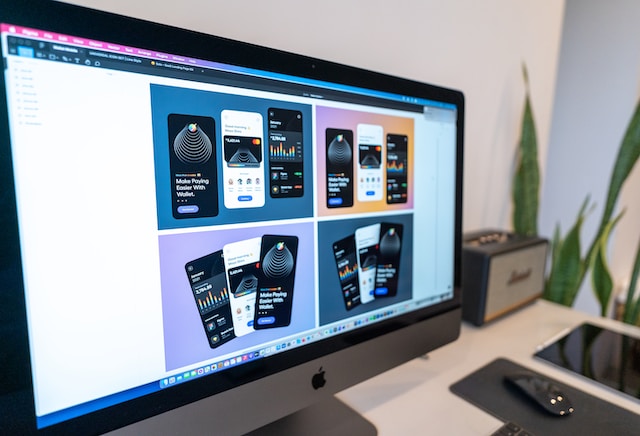Graphic design skills are, without a doubt, essential in today’s visually driven world. Whether creating eye-catching logos, designing sleek website layouts, or developing stunning marketing materials, graphic designers play a crucial role in delivering impactful visual messages to target audiences. In an age where attention spans are shorter than ever, and competition is fierce across industries, the importance of graphic design skills cannot be overstated.
One significant aspect of graphic design is its ability to convey complex information effectively. Through thoughtful use of colors, typography, and other visual elements, graphic designers have the power to simplify complicated concepts and make them easily understandable. With the increasing abundance of data in our digital era, this skill has become even more valuable as businesses strive to communicate their messages concisely and cut through the noise online.
Moreover, strong graphic design skills can contribute to building brand identity and recognition. Logos and branding materials that are thoughtfully crafted with attention to detail can leave a lasting impression on consumers’ minds. By ensuring consistency across various platforms and channels – from social media graphics to packaging designs – companies can establish a strong visual presence, which aids in creating brand loyalty and fostering trust among customers.
In conclusion, having proficient graphic design skills is essential for anyone venturing into the creative field or seeking to enhance their overall communication abilities. Whether it’s simplifying complex ideas or building brand identity through aesthetically pleasing visuals, the impact of effective graphic design cannot be undermined in today’s visually driven world.
Technical Skills: Software Proficiency and Expertise
In today’s digital age, having technical skills and proficiency in software is crucial for graphic designers. Not only does it allow them to bring their creative visions to life, but it also enables them to stay competitive in the ever-evolving field of design.
One key aspect of software proficiency is being well-versed in industry-standard design tools such as Adobe Creative Suite. This suite includes software like Photoshop, Illustrator, and InDesign, which are essential for creating stunning visuals and manipulating images. Additionally, knowledge of design software like Sketch and Figma can be beneficial for collaborating with teams remotely.
However, being proficient in just the main design programs is not enough for a graphic designer looking to stand out from the crowd. It’s essential to be adaptable and continually update your skillset with new technologies that emerge in the market. For example, staying current with motion graphics software or learning website development tools like HTML and CSS can open up new avenues for creativity.
By continuously enhancing their technical skills through constant exploration of different software options available, designers can expand their capabilities and create unique designs that align with current trends while pushing boundaries in their respective fields. The ability to adapt to various tools also signifies versatility—an important trait in an ever-changing industry where clients’ requirements may vary significantly from one project to another.
Overall, a graphic designer’s proficiency in various design-related software demonstrates not only their technical capabilities but also their dedication towards keeping up with advancements within the industry by mastering top-tier tools like Adobe Creative Suite.
Creativity: Thinking Outside the Box
Creativity is a key skill for graphic designers, and thinking outside the box is essential to excel in this field. It involves breaking free from conventional ideas and pushing boundaries to come up with innovative solutions. Rather than following trends, graphic designers need to tap into their imagination and explore different perspectives.
Thinking outside the box allows designers to connect seemingly unrelated concepts and create something unique. Professional logo design services involve looking at problems from multiple angles and finding unconventional solutions that can surprise and delight clients. By challenging norms and questioning assumptions, designers can create work that stands out in a crowded market.
Moreover, thinking outside the box also opens up new opportunities for experimentation and growth. Embracing unconventional approaches encourages designers to try new techniques, explore diverse styles, and discover their own artistic voice. This not only keeps their work fresh but also helps them stay ahead of the curve as advancements in technology constantly reshape the design landscape.
In conclusion, creativity goes hand in hand with thinking outside the box when it comes to being a successful graphic designer. The ability to break free from conventional ideas, connect diverse concepts, question assumptions, and embrace experimentation are all essential skills for staying innovative in this ever-evolving field.
Communication Skills: Understanding Clients’ Needs
Communication is a key skill for graphic designers, and understanding clients’ needs is paramount to deliveringj successful designs. By effectively listening and asking the right questions, designers can gain a deeper understanding of what the client wants to achieve with their design project. It’s not just about delivering aesthetically pleasing visuals; it’s about creating designs that align with the client’s brand identity, target audience, and desired outcomes.
One important aspect of understanding clients’ needs is being able to interpret their feedback and translate it into actionable design decisions. Clients may not always have the technical vocabulary or design knowledge to express what they want in detail. As a designer, it’s essential to bridge this gap by actively seeking clarification when needed and offering suggestions based on your expertise. This collaborative approach fosters trust between the designer and the client, resulting in more successful creative outcomes.
Furthermore, being able to anticipate clients’ needs even before they verbalize them sets exceptional designers apart from others. It requires perceptiveness and empathy – the ability to step into the shoes of the client and understand their vision beyond words. By proactively suggesting solutions or alternatives that align with their goals, designers can demonstrate their value as problem solvers rather than order takers. Ultimately, mastering communication skills will greatly enhance a graphic designer’s ability to deliver outstanding results while fostering strong working relationships with clients.
Typography and Layout: The Art of Visual Presentation
Typography and layout are two crucial elements in graphic design that can make or break a project’s visual appeal. Typography, the art of arranging typefaces, not only conveys a message but also adds personality to a design. Choosing the right typeface can evoke emotions, establish hierarchy, and guide the reader’s eye through the content. A well-designed layout complements typography by organizing elements effectively and creating a harmonious balance between text, images, and white space. A skilled graphic designer understands how to play with different font sizes, weights, and styles to create visually pleasing compositions that capture attention.
One important aspect of typography is understanding its historical significance. By studying typographic trends throughout history, designers can gain insight into which fonts will stand the test of time and which ones will quickly become outdated. Additionally, knowing when to break traditional typographic rules can lead to innovative designs that push boundaries while still maintaining legibility.
In terms of layout design, mastering grids is essential for creating cohesive visuals. Grids provide structure and consistency within a design by dividing it into columns and rows. Skillfully utilizing grids allows for precise alignment of elements while ensuring readability across various devices or formats.
Ultimately, typography and layout work hand in hand to convey information successfully while making an impact on the viewer. Understanding their power is vital for any graphic designer looking to create compelling visual presentations that resonate with their audience.
Attention to Detail: Perfecting Every Element
Attention to detail is a non-negotiable skill for graphic designers. It’s what sets apart the mediocre from the exceptional. Whether it’s choosing the right font, aligning elements perfectly, or making sure colors are consistent, every element of a design requires careful consideration. By paying close attention to even the smallest details, designers can elevate their work and create designs that are visually pleasing and impactful.
One area where attention to detail is especially crucial is typography. The choice of fonts can greatly affect the overall look and feel of a design. Designers need to ensure that fonts are legible, appropriately sized, and well-spaced. Additionally, they must pay attention to kerning (the spacing between individual letter pairs) and leading (the vertical spacing between lines of text) in order to achieve optimal readability.
Another aspect that demands meticulous attention is color selection. Colors have emotional connotations and evoke different feelings in viewers. Designers need to be aware of color theory when creating their designs and understand how different colors interact with each other. They should also consider factors like contrast, saturation, and brightness in order to create harmonious color palettes that effectively convey the desired message.
In conclusion, attention to detail is an essential skill for any graphic designer who aims for excellence in their work. Perfecting every element in a design helps create cohesive visuals that effectively communicate the intended message while leaving a lasting impression on viewers. By paying close attention to typography choices and ensuring the correct use of colors, designers can showcase their skills.
Time Management: Meeting Deadlines and Prioritizing Tasks
Time management is a crucial skill for any professional, but it holds even more weight in the field of graphic design. As a graphic designer, meeting deadlines is essential to ensure projects are delivered on time and clients are satisfied. Prioritizing tasks is equally vital; it allows designers to allocate their time effectively and tackle projects in order of importance.
One effective strategy for meeting deadlines and prioritizing tasks in graphic design is creating a detailed schedule or plan at the start of each project. This allows designers to break down the project into smaller tasks, estimate how long each task will take and set specific deadlines for each stage. By doing so, designers can easily track their progress and ensure they stay on track to meet their final deadline.
Another important aspect of time management for graphic designers is learning to say no when necessary. While it’s tempting to take on every project that comes your way, overloading yourself with work can lead to burnout and lower-quality output. Being selective about the projects you take on not only helps you manage your time more effectively but also ensures that you have enough energy and focus to deliver high-quality results.
In conclusion, effective time management skills are crucial for success as a graphic designer. By meeting deadlines and prioritizing tasks through careful planning, tracking progress, and being selective about projects taken on, designers can optimize their productivity while maintaining high standards of workmanship.
Conclusion: Essential Skills for Successful Graphic Design
In conclusion, there are several essential skills that are crucial for successful graphic design. First and foremost, a strong understanding of design principles such as color theory, typography, layout, and composition is necessary. These foundational skills allow designers to effectively communicate their ideas visually.
Additionally, problem-solving and critical thinking skills are vital in the field of graphic design. Designers often encounter challenges or client requests that require innovative solutions. The ability to think creatively and analytically allows designers to navigate these obstacles and create effective designs that meet both the client’s objectives and user needs.
Lastly, staying up to date with the latest industry trends and software is key in this fast-paced field. Technology continually evolves, so graphic designers must constantly adapt to new tools and techniques. By keeping current with industry standards, designers can produce work that is fresh, relevant, and competitive.
By honing these essential skills – mastering design principles, cultivating problem-solving abilities, and staying current – aspiring graphic designers can position themselves for success in an ever-changing profession. So, whether you’re just starting your journey or seeking career growth as a seasoned professional, never underestimate the importance of continuously developing your skillset to thrive in the world of graphic design.





